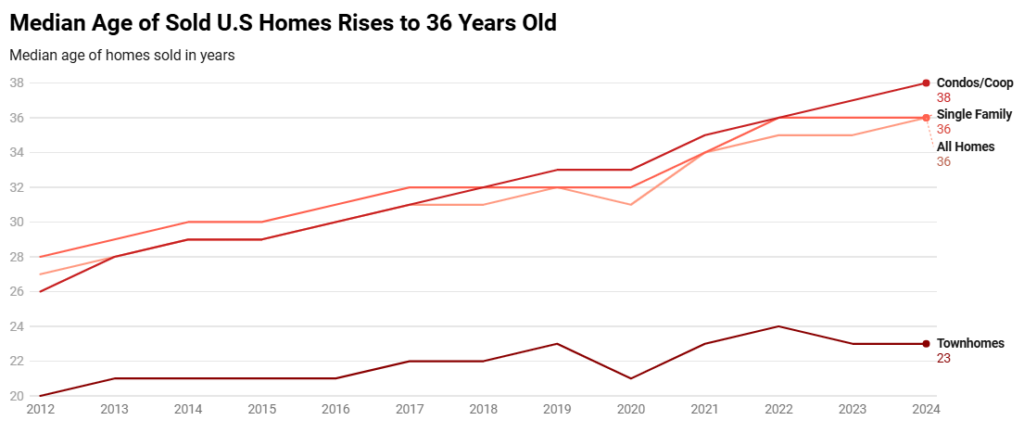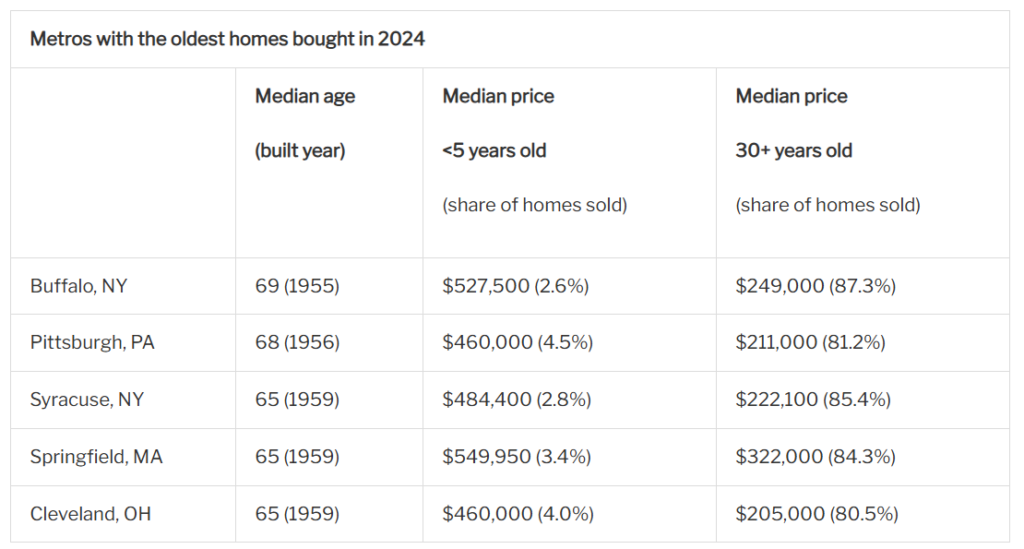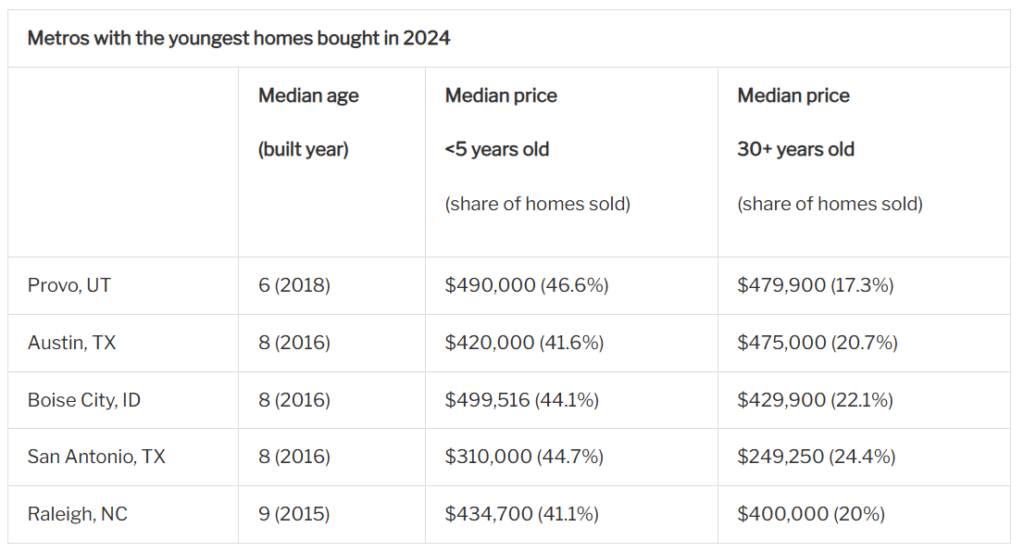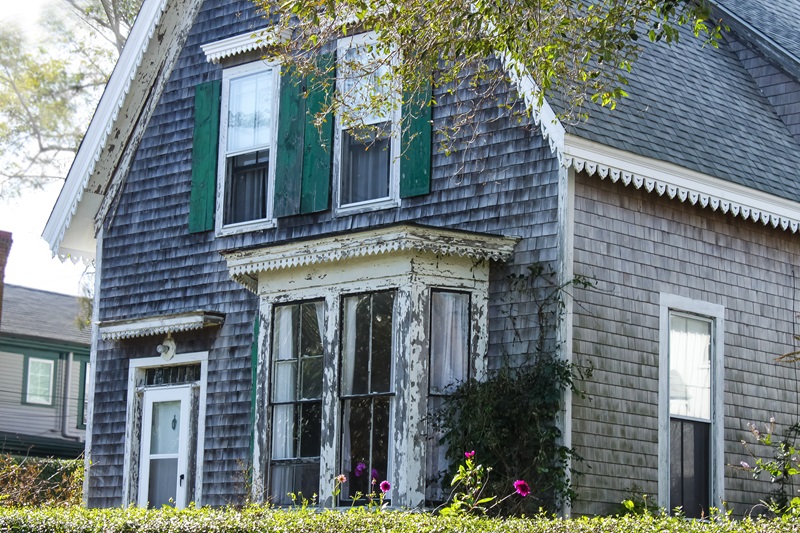Highlighting how a lack of new construction over the past 15 years has fast-tracked the aging of America’s housing stock, the typical home bought in the U.S. hit a record age of 36 years in 2024, according to a new report from Redfin. That’s nine years older than the median age of homes purchased in 2012.
Redfin analyzed MLS data, looking at the age of homes bought between 2012 and 2024. “Newer homes” were defined as being less than five years old, and “older homes” as being more than 30 years old. Data referred to all home types (i.e. single-family, condos, and townhouses) combined.
The homes people are buying are getting older across all types, with condos aging the most—to a median 38 years in 2024, from 26 years in 2012.

There are two main reasons Americans are increasingly buying older homes: lack of new supply and affordability. There have been fewer homes built in the past two decades, in comparison to earlier decades. That’s especially true on the East Coast and in the Rust Belt, where the median age of sold homes can be more than 60 years. And, generally, older homes are cheaper than new homes: the typical 30-plus-year-old home sells for 15% less than the median price of all homes.
“America’s housing stock is getting older by the year, and it’s not because buyers prefer vintage homes—it’s because we haven’t built enough new ones,” said Redfin Senior Economist Sheharyar Bokhari. “Without more construction, buyers are forced to choose from a pool of aging properties that present a new set of financial challenges, especially for those trying to save enough money to climb onto the property ladder. Older homes have aging systems, energy inefficiencies, and a steady stream of maintenance costs that can quickly add up after move-in.”
Less Than 10% of U.S. Homes Were Built in the 2010s
The U.S. has been building fewer homes since the 2008 global financial crisis. Only 9% of America’s homes were built in the 2010s—the lowest share of any decade since the 1940s, when World War II put a halt to construction.
The good news is that residential construction in the 2020s has picked up slightly, thanks in part to the pandemic-fueled building boom in many Sun Belt and Mountain West states. But it’s not enough: at current speeds, the number of homes built is projected to be the second lowest of any decade since the 1940s.
Price Gap Shrunk Considerably
In 2012, the typical price buyers paid more for a newer home (less that five years old) than an older one (30-plus years old): 77.9% more, $243,730 versus $137,000, respectively. But in 2024, that gap had shrunk to just 31.6% ($425,000 vs. $323,000).
While older homes have traditionally been more affordable than newer ones—due to factors such as depreciation, outdated features, and the potential need for repairs—they may require significant upgrades to meet current standards. That’s unlike new construction, which typically includes modern designs, updated systems, and energy-efficient materials.
Smaller Premiums for Newer Homes
In 2024, homebuyers paid 11.8% more for a newer home (less than five years old), compared to the median home price, whereas in 2012, they paid 44.4% more. Meanwhile, they’re not getting as big a discount for purchasing an older home. In 2024, the typical older home (30-plus years old) sold for 15% less than the median home price. In 2012, buyers paid 18.9% less.
Why is the Price Gap Shrinking?
- More affordable home types: Builders are constructing smaller, lower-cost homes, such as townhouses, which now make up nearly 20% of new housing (a record high).
- Construction in cheaper areas: More new homes are being built in traditionally affordable regions, such as the Sun Belt and Mountain West. Demand in some of these areas (like Florida and Texas) is now declining, causing home prices to fall and listings to surge.
- Prices rising in older metros: Strong demand in areas with older housing stock, such as metros on the East Coast and in the Rust Belt, is helping to drive up prices of older homes.
Regional Trends
The typical home that sold in Buffalo in 2024 was 69-years-old—the oldest among the 100 most populous metros with sufficient data that Redfin analyzed. Highlighting the lack of new inventory, only 2.6% of bought homes in Buffalo were less than five years old.
Metros with the oldest homes bought in 2024:

Next came Pittsburgh, with a median home age of 68-years-old, followed by Syracuse, New York; Springfield, Massachusetts; and Cleveland, Ohio—all of which had a median age of 65 years. There’s a wide gap between the median price of newer homes and older homes in these metros, with homes over 30 years old typically selling for less than half the price of those built in the past five years.
“Older homes may cost less upfront, but the cost of repairing or replacing big ticket items can be a huge burden for buyers,” said Jerry Quade, a Redfin Premier Agent in Cleveland. “We always take a close look at the plumbing and electrical systems, along with the concrete foundations and the roof. Most of the old homes in Cleveland have basements, so we also look for any signs of water intrusion. At the end of the day, getting a building inspection is critical.”
It’s a very different story in Provo, Utah, where the typical home that sold last year was only six years old—the youngest of the metros Redfin analyzed. The price of an older home ($479,900) in Provo was nearly as high as a newer home ($490,000).
Next on the young homes list were Austin, Texas; Boise City, Idaho; and San Antonio, Texas—where the median home that sold was eight-years-old.
Metros with the youngest homes bought in 2024:

Austin, Texas is one of only four metros Redfin analyzed where the median price of a home over 30 years old cost more last year than a home built in the past five years. The other three metros were found in California: Oxnard, San Jose, and San Francisco. Raleigh, North Carolina rounded out this top five list, with the typical sold home being nine-years-old.
Click here for more on Redfin’s analysis of the nation’s aging housing inventory.






